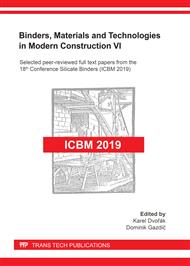[1]
L. Smith and F. Placido, Thermoliminescence: A comparison with the residual strength of various concrete, Fire safety of concrete structures, ACI 80 (1983) 293-304.
Google Scholar
[2]
K.D. Hertz, Residual properties of concrete heated rapidly, Evaluation and Repair fire damage to concrete, ACI 92 (1986) 143-152.
Google Scholar
[3]
T.T. Lie, T.J. Rowe, and T.D. Lin, Residual strength of fire-exposed reinforced concrete columns, ACI 92 (1986) 153-174.
Google Scholar
[4]
R. Jansson, Thermal stress cause spalling, Branpostend 33 (2006) 24-25.
Google Scholar
[5]
V.Q. Le, M.Q. Do, M.D. Hoang, T.P. Dang, T.H. Bui, H.T. Nguyen, Evaluation on Roles of Activated Silicon and Aluminum Oxides for Formation of Geopolymer from Red Mud and Silica Fume, Key Engineering Materials, 777 (2018) 513-517.
DOI: 10.4028/www.scientific.net/kem.777.513
Google Scholar
[6]
H.T. Nguyen, H.L.N. Nguyen, T.N.U. Vo, T.K. Pham, Novel materials synthesized from red mud, bagasse, and bentonite for gas treatment by CO2 absorption, MATEC Web of conferences 207, 03005 (2018).
DOI: 10.1051/matecconf/201820703005
Google Scholar
[7]
H.T. Nguyen, T.N. Le, V.T.H.Q. Pham, Development of heat resistant geopolymer-based materials from red mud and rice husk ash, AIP Conf. Proc. 1954 (1) (2018) 040005.
Google Scholar
[8]
V.Q. Le, M.Q. Do, H.T. Nguyen, Effect of Alkaline Activators to Engineering Properties of Geopolymer-Based Materials Synthesized from Red Mud, Key Eng. Mat. 777 (2018) 508-512.
DOI: 10.4028/www.scientific.net/kem.777.508
Google Scholar
[9]
Q.M. Do, T.H. Bui, H.T. Nguyen, Effects of Seawater Content in Alkaline Activators to Engineering Properties of Fly Ash-Based Geopolymer Concrete, Sol. Sta. Phe. 296 (2019) 105-111.
DOI: 10.4028/www.scientific.net/ssp.296.105
Google Scholar
[10]
P.T. Kien, T.T.T. Ly, N.H. Thang, M.M.A.B. ABDULLAH, A Novel Study on Using Vietnam Rice Hush Ash and Cullet as Environmental Materials, MATEC Web of Conferences 97, 1-6.
DOI: 10.1051/matecconf/20179701118
Google Scholar
[11]
H.T. Nguyen, Evaluation on Formation of Aluminosilicate Network in Ternary-Blended Geopolymer Using Infrared Spectroscopy, Solid State Phenomena 296 (2019) 99-104.
DOI: 10.4028/www.scientific.net/ssp.296.99
Google Scholar
[12]
H.T. Nguyen, V.T.H.Q. Pham, Leachability of heavy metals in geopolymer-based materials synthesized from red mud and rice husk ash, AIP Conf. Proc. 1954 (1) (2018) 040014.
DOI: 10.1063/1.5033414
Google Scholar
[13]
H.T. Nguyen, V.T.H.Q. Pham, T.N. Le, T.P. Dang, N.K.T. Nguyen, Utilization of red mud and bagasse for production of gas absorption materials, AIP Conf. Proc. 1954 (1) (2018) 040010.
Google Scholar
[14]
H.T. Nguyen, V.Q. Le, T.H. Bui, Leaching Behavior and Immobilization of Heavy Metals in Geopolymer Synthesized from Red Mud and Fly Ash, Key Eng. Mat., 777 (2018) 518-522.
DOI: 10.4028/www.scientific.net/kem.777.518
Google Scholar
[15]
H.T. Nguyen, N.H. Nguyen, V.T.H.Q. Pham, Engineering properties of lightweight geopolymer synthesized from coal bottom ash and rice husk ash, AIP Conf. Proc. 1954 (1), 040009.
DOI: 10.1063/1.5033409
Google Scholar
[16]
H.T. Nguyen, Synthesis and Characteristics of Inorganic Polymer Materials Geopolymerized from Ash of Brickyard, Materials Science Forum 961 (2019) 45-50.
DOI: 10.4028/www.scientific.net/msf.961.45
Google Scholar
[17]
J.T. Kloprogge, R.L. Frost, Thermal decomposition of bauxite minerals: infrared emission spectroscopy of gibbsite, boehmite and diaspora, J. of Mat. Sci. 37 (6) (2002) 1121-1129.
Google Scholar


